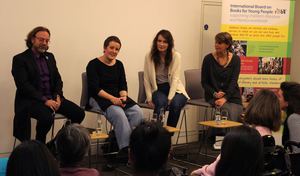IBBY Honours List 2016 event at Waterstones

Laura Carlin, our illustrator for her work on The Promise, written by Nicola Davies, talked to Carol Thompson, herself an illustrator. Laura had been drawn to the book because of the magic of the text ” it’s almost like poetry” – a life-affirming story about a girl, who despite herself, changes her world . When offered the text she had found it visually rich; so much so, there was a danger of repeating images. The challenge had been to make a real world alongside the text and imagine a girl who then stepped off the page for Laura. This was her first picture book; her previous work had been to illustrate The Iron Man by Ted Hughes. It had been Walker Books that provided the opportunity for Laura to work with Nicola. She confessed it had not been the easiest of journeys. For the first time she had to think about her audience. “It was a massive learning curve”; a real lesson in collaboration, not just between illustrator and author, but also editor and designer. This had affected how the illustrations developed from grim and grimy to green. Carol commented on the texture of the illustrations. This had fed in from Laura’s work with ceramics. When asked about artists she admired, she cited illustrators like John Burningham and Quentin Blake – artists who do not patronise their child audience; who retain their playfulness. Laura has already won accolades – she was the Grand Prix winner of the Bratislava Biennale – and hearing her talk about her work we were in no doubt as to why.
Finally we heard from our nominated author, S.F. Said, already known to many for his novels about Varjak Paw. Here our nominated book is his novel Phoenix. Talking to Ann Lazim he led us through his career to the moment he realised that he had to write for children. Echoing Philip Pullman he feels that children’s books are completely inclusive. It is layered – to the younger reader Varjak Paw is an exciting story about a cat, to an adult reader it is about difference, diversity and inclusion. When asked if Varjak would return after two adventures. Possibly – but he was very clear that he cannot write unless he has a story. After a period when as he said “he fell out of love with writing” he had an idea – a boy on an epic quest to find his family – a quest that takes him across the galaxy. This was the genesis of Phoenix. It is a space epic. But you cannot exclude personal interests and concerns. Thinking about aliens (who do feature in the novel), what is an alien? Someone who is different. The story became not merely an exciting adventure, it is about difference, diversity, friendship across barriers, empathy and connection; a themes very relevant in the world today. He likes the idea of taking a “genre” form and done something a little different with it. One of the features that makes Phoenix stand out, are the illustrations by David McKeen. They had worked together on Varjak Paw but in the case of Phoenix it was a real collaboration, and Said even designed some of the sequences – moments that could not be described in words. Sadly Phoenix has not been translated out of English which is surprising. The arguments are familiar – only boys read science fiction and boys don’t read! As Said pointed out neither statement is true. He was thrilled to be on the IBBY Honour List – “What an amazing organisation.” It was a real accolade and exciting to see his book next to authors from across the world. Of course, one of the aims of the Honour List is to attract attention to books from around the world – we must hope that it will do this for this novel which reflects so much the message IBBY promotes.
It was an inspiring and enjoyable evening. A privilege meet our Honour Book nominees – and we must look forward to more such occasions.
